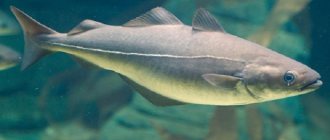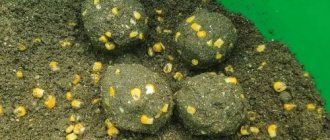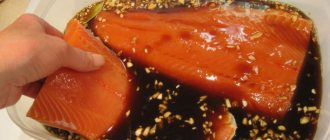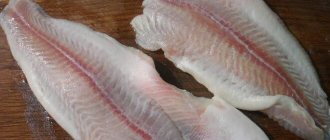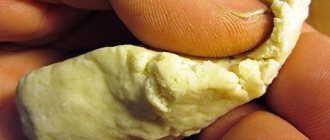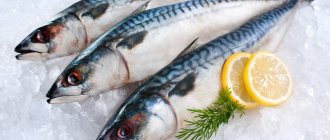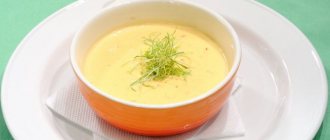What kind of fish is this and where is it found?
Tilapia is a generic name that unites several hundred species of freshwater fish of the cichlid family. Initially, fish of this genus lived mainly in Asia Minor and Africa, but thanks to people they became widespread in Europe, Latin America and Southeast Asia.
In terms of external characteristics, the different species do not differ much from each other and have a short, slightly laterally compressed body and a large head with large eyes, typical of cichlids. Their color is most often silver with a greenish tint. The average weight of fish ranges from 1 to 1.5 kg.
Tilapia are considered almost omnivores, but most of their diet consists of plant matter, such as phytoplankton and large algae. Organic bottom sediments occupy an important place in the nutrition of many species.
The main property of fish of the tilapia genus is their ability to adapt to sudden changes in environmental conditions. Although tilapia prefer tropical climates and are freshwater fish, they are able to survive in seawater and can withstand fairly low temperatures.
Easy care and excellent taste make these fish valuable objects for industrial cultivation. They are actively bred in artificial reservoirs in China, Latin America and the USA.
Description of the species
This mysterious name hides the Tilapia fish, which belongs to the Cichlid family. This type of fish is freshwater, its usual habitat in nature is the tropics. The fish can be found in Africa and Asia. Individuals of this species are artificially grown in the USA, China and Asia.
Tilapia are omnivorous and quickly adapt to changing environmental conditions. Fish can easily be in a body of water with any water temperature; in addition, they reproduce quickly.
The appearance of the “chicken” has a number of characteristics: its body is short and tall, slightly flattened on the sides. The scales have a silvery tint with tints of red and green.
“Freshwater chicken” is so called due to its tender meat with a high protein content. Telapia fillet can often be found in recipes for various dishes.”
What are the benefits of tilapia?
Despite rumors about the dangers of tilapia, it is difficult to ignore its benefits for the human body. Nutritionists recommend eating this fish fillet to everyone, especially children, as well as pregnant and lactating women.
For adult men and women
The beneficial properties of tilapia for adults are that its fillet contains half the daily requirement of protein, which is a building material for cells and is involved in all processes of the human body. Protein is especially important for people who exercise intensively, as it actively participates in the formation of muscle mass.
Vitamin E, which is part of fish, ensures the elasticity of blood vessels and the elasticity of the skin, which eliminates the danger of thrombosis and prolongs youth.
For the elderly
Tilapia is no less useful for older people. The magnesium and Omega-3 acids found in fish regulate blood cholesterol levels, normalize blood pressure, reduce the risk of heart and joint diseases, maintain healthy vision, and inhibit inflammatory processes in the body. Phosphorus and potassium, in turn, ensure bone strength and reduce the likelihood of developing dementia and Alzheimer's disease.
Compound
Tilapia has a number of beneficial properties. Eating their meat normalizes heart function, the condition of blood vessels, reduces the risk of developing dangerous diseases, lowers the level of bad cholesterol, promotes the formation of muscle tissue, and strengthens the immune system. Doctors recommend eating tilapia to prevent many diseases, such as thrombosis and atherosclerosis. Fish contains the following substances:
- easily digestible low-calorie protein;
- fatty acid;
- mineral complex (iron, selenium, magnesium, sodium, calcium, potassium, zinc, phosphorus);
- vitamins (B1, B2, B5, B6, B9, B12, E, K, PP, ascorbic acid).
Is it possible to give tilapia to children?
Since tilapia has a tender, almost boneless fillet that softens well when cooked, it is quite suitable for baby food. As a rule, they begin to accustom a child to such food at 7-8 months, provided that the child is bottle-fed. Breastfed children do not need early complementary feeding.
Important! Before introducing fish into your child's diet, it is recommended to consult a doctor.
An ideal option for complementary feeding would be fish puree. When feeding fish for the first time, you should limit yourself to 1 tsp. for meals. The next portion should be given no earlier than 24 hours later. During this time, it will become clear whether the child has allergic reactions to tilapia. If after a period of time no such reactions are detected, you can gradually increase the dosage to 50 g per dose.
Tilapia is good for children of any age, as it contains phosphorus, which helps absorb calcium and plays an important role in the formation of bone tissue.
Application for weight loss
Due to the content of easily digestible protein of animal origin, tilapia provides a feeling of fullness for a long time. This helps reduce the amount of food consumed and eradicate the habit of unhealthy snacks, which is very important and useful when losing weight.
Low fat content and lack of carbohydrates makes tilapia one of the main fish products in the diet menu.
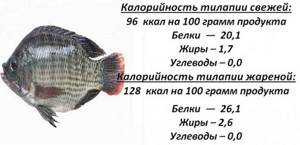
It is recommended to combine it with light vegetable salads or simply with fresh vegetables to obtain additional vitamins and minerals. When losing weight, tilapia is consumed boiled. The best option is to steam the fish.
Recommendations for eating tilapia
Although tilapia fillet has many beneficial properties, many people are afraid to eat it. Since tilapia is an omnivorous fish, it is believed that it feeds on harmful human waste, as a result of which it accumulates toxins in its body. However, this is a misconception. All hazardous substances, if any, are retained in the liver of the fish, which, like the human liver, performs a protective function and neutralizes the effects of poisons. Therefore, before eating, tilapia should be gutted and washed thoroughly. This will also reduce the risk of infection from pathogenic bacteria that may be present in the fish.
Cooking recipes
Dietary fish soup from king perch
This simple, mouth-watering recipe makes for a healthy, everyday lunch. It is prepared with vegetables, but without potatoes.
- Peel the onion, cut it into cubes or thin half rings (a matter of taste). Then fry it lightly in vegetable oil.
- Prepare the pepper for frying - peel it and chop it thinly. Place in the pan with the onions along with chopped celery. Fry for 5 minutes, stirring constantly.
- Bring the water in a saucepan to a boil, add the sautéed vegetables. Immediately add your favorite spices.
- Add tomato sauce and beans. The first ingredient can be replaced with mashed canned tomatoes in their own juice.
- Cook for 10-15 minutes. During this time, cut the tilapia fillet into small pieces and place it in the pan.
- The last ingredient is canned corn. Boil the soup until fully cooked.

For 6 servings:
- tilapia – 350 g;
- vegetables (onions, bell peppers) – 1 pc.;
- celery – 1 stalk;
- green beans – 200 g;
- tomato sauce – 300 g;
- canned corn – 150 g;
- vegetable oil - a few tablespoons;
- seasonings
Steamed fish
This is the healthiest recipe with tilapia, which you can choose any side dish for.
- Place the meat in a steamer and bring to a boil.
- Make several cuts on each side diagonally. Add garlic, ginger, ground pepper. Pour half the prepared volume of soy sauce inside.
- Place the fish on a plate, pour in the remaining soy sauce and lemon juice. Sprinkle the carcass with ginger, garlic, and pepper on top. Steam for another 20 minutes. Pour the finished fish with sesame oil.

Ingredients:
- tilapia – 700 g;
- soy sauce – 4 tbsp. spoons;
- lemon juice – 1 tbsp. spoon;
- sesame oil – 1 tbsp. spoon;
- grated garlic – 2 tbsp. spoons;
- ginger – 1 tbsp. spoon;
- black pepper (ground).
How to cook tilapia fillet
There are many recipes for tilapia fillet dishes. It can be stuffed, steamed, boiled, baked in foil, smoked, and in combination with drier fish it becomes an excellent filling for pies. But the most popular and fastest ways to cook tilapia are to bake in the oven or fry.
Tilapia baked in the oven
To prepare 4 servings of the dish you will need:
- peeled fish fillet - 4 pcs.;
- medium-sized lemon - 1 pc.;
- mayonnaise - 4 tbsp. l.;
- any greens - 2 tbsp. l.;
- horseradish - 2 tsp;
- garlic spice - 1 tsp;
- salt and pepper to taste.
We recommend reading: Benefits of bell pepper, properties
- Cover the baking sheet with foil and place the fillets on it without adding oil. Sprinkle with salt, pepper and garlic spice and bake for 20 minutes at 200C°.
- The lemon is peeled and the zest is ground in a blender.
- Horseradish, mayonnaise and finely chopped herbs are mixed for sauce, add 1 tsp to the mixture. lemon zest.
- The finished fillet is sprinkled with lemon juice and served with sauce as a separate dish or with a side dish of vegetables, pasta or rice.
We recommend reading: Chili peppers: benefits and harms, properties, how to eat them
Tilapia in batter
For 4 servings you need:
- tilapia fillet 8 pcs.;
- flour 300 g;
- chicken egg 2 pcs.;
- vegetable oil 2 tbsp. l.;
- salt, pepper and herbs - to taste.
- The washed fillet is cut into pieces.
- Beat the eggs thoroughly with a fork or blender until smooth.
- Mix flour with salt and pepper.
- The fillet pieces are first rolled in flour, and then in egg, then placed in a frying pan with heated vegetable oil.
- Fry the fish on both sides for 7 - 8 minutes until golden brown.
- Place the finished fillet on a paper towel to remove excess oil. Served hot with a side dish.
Advice! In addition to eggs, you can use milk, kefir or beer as a base for the batter.
Tilapia calorie content, nutritional value
Tilapia fish, the benefits and harms of which are determined by its composition, is low-calorie - 100 g of product contains 120 kcal. This figure may increase depending on the cooking method. So, as a result of frying fish in batter, the calorie content will be 170 kcal.
The table below shows the ratio of BZHU product:
| Squirrels | 86,2% |
| Fats | 10,4% |
| carbohydrates | 3,3 % |
Fish, according to the indicated values, with low calorie content and low fat content, contains a large amount of protein (100 g of product compensates for 29% of the daily protein requirement).
Harm of tilapia and contraindications for use
The main disadvantages of tilapia include the incorrect combination of Omega-3 and Omega-6 fatty acids.
Attention! The Omega-6 and Omega-3 acids contained in tilapia, which are important for their benefits, in the human body should have a 1:1 ratio, the violation of which in the direction of Omega-6 threatens the development of inflammation and disruption of the immune system.
Recent studies by American nutritionists have shown that in tilapia fillet the level of Omega-6 acid can exceed the level of Omega-3 by more than 4 times.
Omega-6 itself has the beneficial property of lowering blood cholesterol levels. However, it also has a negative reputation as an inflammatory fatty acid, while Omega-3 has proven anti-inflammatory effects.
However, tilapia is not as serious as it may seem. The Omega-6 content in it is much less than the critical value. However, you should observe moderation and eat this fish no more than 2 - 3 times a week.
Also, tilapia should not be abused by people suffering from:
- bronchial asthma;
- allergies;
- individual intolerance to the product;
- diseases of the cardiovascular system;
- arthritis and other joint diseases.
How to choose tilapia when buying
To purchase the most useful product, you should pay attention to the appearance of the tilapia.
- An uncut carcass's eyes should be transparent and shiny. If the eyes are cloudy, there is a high chance that the fish is not fresh.
- Preference should be given to carcasses with pale, intact scales and long fins, which are a sign that the fish was raised on natural feed.
- Fresh tilapia has a faint river aroma. If the product smells like medicine, most likely the fish has been chemically treated for better storage.
- When purchasing fillets, you should choose a product that has a uniform, soft color. Too rich a color is an indicator of the presence of harmful food additives in the fish. Natural fillets may contain bones.
- It is best to purchase chilled fillets, since tilapia loses a significant part of its beneficial properties during freezing.
It is very important to purchase tilapia from reputable places, since it is not always possible to determine the quality of the product by eye. This is often taken advantage of by irresponsible fish farmers who breed unpretentious fish in contaminated or dirty reservoirs, feeding them with antibiotics to accelerate growth. Tilapia fillets grown in this way will do more harm to the body than good.
Advice! When buying fish, you should ask the seller for a quality certificate.


